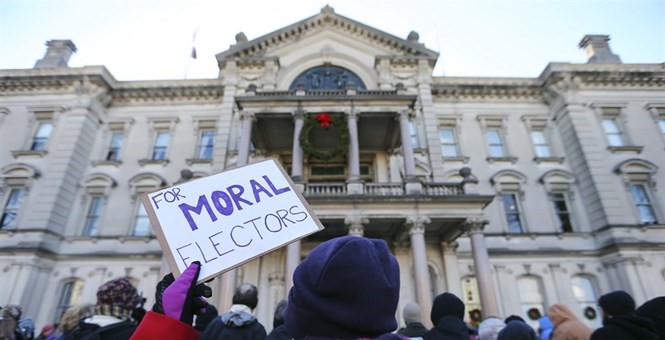The Sneaky Efforts to Undermine the Electoral College
Laura Hollis |May 24, 2018
The Electoral College is being challenged as an anachronism. These complaints have largely been prompted by the 2000 and 2016 presidential elections; in both, the victor won by garnering the requisite number of electoral votes, despite losing the national “popular vote.” (That has happened only five times in the nation’s history: 1824,1876,1888,2000 and 2016.)
The race between George W. Bush and Al Gore in 2000 produced painstaking recounts in the state of Florida, a Supreme Court opinionand entry of the term “hanging chad” into the national lexicon. But when all was said and done, George W. Bush had won the state of Florida — albeit by only 537 votes — taking Florida’s 25 electoral votes and winning the presidency.(Only five electoral votes separated Bush’s 271 from Gore’s 266.)
If Democrats and other left-leaning voters were angry about the 2000 election, they were apoplectic when Donald Trump beat Hillary Clinton in 2016. Trump won the Electoral College handily, receiving 306 electoral votes to Clinton’s 232, despite Clinton receiving a larger portion of the popular vote: 65.8 million votes to Trump’s 62.9 million.
The ire is grounded in a fundamental misunderstanding of the Constitution, and the role of Electoral College in electing the president. The Constitution is structured to mitigate the effects of pure democracy — which always favors the majority — with procedures that protect minority or underrepresented voices.
Take Congress, for example. The House of Representatives and the Senate are structured differently. The number of representatives each state has is a function of the state’s population; the larger the population, the greater the number of representatives. California, our most populous state, sends 53 representatives to the House. Wyoming, our least populous state, has only one. The Senate, on the other hand, consists of 100 elected senators — two from each state, regardless of its population.
And why is this?
The answer is balance. The structure of the Senate is intended to offset the majoritarian effect of the House of Representatives, and to ensure that states with smaller populations get an equal voice in the federal legislative process.
So it is with the Electoral College. By assigning electors (and their votes) to the candidate who wins the most votes in any given state, the Constitution establishes a system that elevates the impact of smaller, less populous states, and creates an incentive for presidential candidates to cultivate the support of the residents of those states.
As the Electoral College is in the U.S. Constitution, eliminating it outright would require amending the Constitution. An amendment to the Constitution requires the support of two-thirds of both the House and Senate (or a Convention of States), followed by ratification of any such amendment by three-quarters of the states’ legislatures (38 states). This is no mean feat; the Constitution has only been amended 27 times in 229 years.
However, efforts are afoot to eviscerate the Electoral College without amending the Constitution.
Specifically, the National Popular Vote initiative seeks to get enough state legislatures to pass a law whereby the state’s electoral votes will go to the winner of the popular vote nationally, regardless of the results in that particular state. Connecticut is the latest state to have joined the compact, passing such a law this month.
Here’s how this works: Let’s say that Smith and Jones are running for president in 2020. Smith wins in Connecticut. But Jones gets more actual votes across the country. Connecticut’s 7 electoral votes would go, therefore, not to Smith – for whom a majority of Connecticut voters voted – but to Jones.
Unlike the process of amending the Constitution, the National Popular Vote compact only requires enough states to hit the magic number of 270 electoral votes. At present, the compact has 172 dedicated electoral votes from the 11 states which have enacted the law: California (55), New York (29), Illinois (20), New Jersey (14), Washington (12), Massachusetts (11), Maryland (10), Connecticut (7), Rhode Island (4), Hawaii (4), Vermont (3) and the District of Columbia (3).
This compact is being touted by its supporters as being more “fair” than the current system. It is no such thing. Such a law effectively disenfranchises the voters of the states that pass it, in favor of large, highly populated states like California, New York and Illinois. In both the 2000 and 2016 elections, the popular vote majorities were established by virtue of voters in California alone. One state, therefore, out of 50, would have effectively determined the outcome of the presidential election under the National Popular Vote compact. A presidential candidate can safely ignore less populous states which have passed such a law, knowing that their electoral votes will go to the winner of California, New York and Illinois.
It is no coincidence that the 11 states where the compact has passed are Democratic strongholds where Hillary Clinton won in 2016; they are still bruised and seething from her loss to Trump.
But it is no more “fair” to hand over your state’s electoral votes to the winners of states like California or Illinois, than it would be to demand that the structure of the U.S. Senate be changed so that more populous states have more senators than less populated ones. Both tactics would undermine the balance of power that is the cornerstone of the Constitution, and render smaller, more rural states effectively voiceless in national government.
The National Popular Vote compact is an underhanded way to gut the Constitution without amending it, and to disenfranchise large swaths of the American electorate. It should be opposed.

